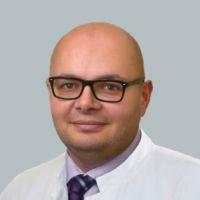Recommended specialists
Article overview
Thoracic surgery - Further information
The aorta stretches from the heart through the chest and into the abdomen, and is the major artery supplying your body with blood. It is around one foot long and approximately one inch in diameter.

Symptoms of Abdominal Aortic Aneurysm
Abdominal aortic aneurysms characteristically grow at a slow rate and mostly without signs or symptoms. This makes them hard to detect, though not all aneurysms will rupture. Many start off small and change very little, while others increase in size as time passes. Nevertheless, some can expand rapidly, and this variance can make predictions about the growth of an abdominal aortic aneurysm quite difficult.
When an abdominal aortic aneurysm is growing, some may experience:
- a pulsing near the navel
- a constant pain deep in the abdomen, or at the side of the abdomen
- back pain that is sudden and severe
Should any of these symptoms occur, you should seek immediate emergency help.
Causes of Abdominal Aortic Aneurysm
Experts currently don’t know the exact cause of an abdominal aortic aneurysm. Even so, there are certain recognised risk factors, such as:
- high blood pressure (hypertension) – your blood pressure is calculated as the level of pressure exerted on the walls of your blood vessels. The walls of your aorta can be weakened by high blood pressure, and this makes an aneurysm more likely to occur.
- smoking – this habit risks damaging your artery walls and makes them more susceptible to bulging. Smoking also increases your risk of developing high blood pressure.
- vascular infection (vasculitis) – on rare occasions, a serious infection can occur within the aorta and other arteries, which may result in an abdominal aortic aneurysm.
While aneurysms can develop in any of the body’s blood vessels, abdominal aortic aneurysms are more serious due to the relative size of the aortic artery.
Diagnosis of Abdominal Aortic Aneurysm
A diagnosis of an abdominal aortic aneurysm usually requires a physical examination, together with a medical history. If an aortic aneurysm is suspected, the tests used to confirm this diagnosis could include:
- abdominal ultrasound – this test is used to look for internal signs of an abdominal aortic aneurysm.
- CT (computerized tomography) scan – CT scanning uses X-rays to create images of your body. This process makes it easier to locate an aneurysm and map its details.
- MRI (magnetic resonance imaging) scan – this is an alternative method of detecting an aneurysm, which uses radio-wave pulses to generate body images.
Treatment of Abdominal Aortic Aneurysm
The aim is to prevent your aneurysm from rupturing, and the usual treatment options are medical monitoring or surgical intervention. The final choice will be influenced by the dimensions of the aortic aneurysm and the rate at which they are increasing.
Medical monitoring
Medical monitoring may be recommended where the abdominal aortic aneurysm is small and without symptoms. Regular appointments will check the growth of your aneurysm and manage other medical conditions that may potentially increase your risk.
Surgery
Surgery may be recommended for an abdominal aortic aneurysm if:
- the aneurysm is about 1.9 to 2.2 inches, or larger
- the aneurysm is fast-growing
- stomach pain is present
- the aneurysm is leaking, tender or painful
Surgical options may include
- open abdominal surgery – this procedure removes the damaged part of the aortic artery, which is replaced with a synthetic graft, stitched in place.
- endovascular surgery – this less-invasive procedure repairs an aneurysm by inserting a synthetic graft using a thin catheter tube. This is placed inside a leg artery and then gradually threaded through to your aorta. This device reinforces the weakened part of your aortic artery and thus prevents a rupture.
The decision about treatment options will involve a range of factors, such as your age, the location and dimensions of the aneurysm, and any pre-existing health conditions, which may increase the risk of surgical intervention or endovascular reinforcement.
Chances of recovery from Abdominal Aortic Aneurysm
It may take up to six weeks to recover from open abdominal surgery, whereas you are likely to recover from endovascular surgery within 14 days. The chances of surgery being successful are much greater if an abdominal aortic aneurysm is discovered before it ruptures.
Prevention of Abdominal Aortic Aneurysm
Good heart health is the key to lowering the risk of an abdominal aortic aneurysm. This involves:
- a healthy diet
- taking regular exercise
- quitting smoking
Your doctor may also recommend medicines to control high blood pressure, cholesterol levels and diabetes.















